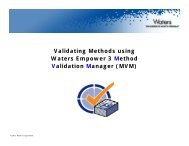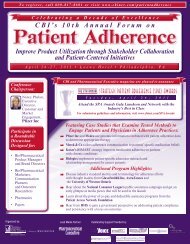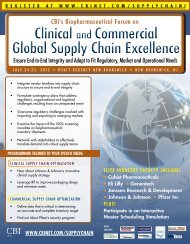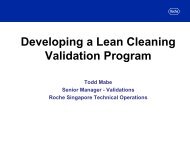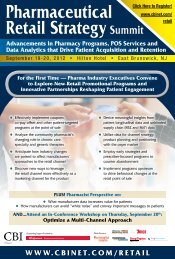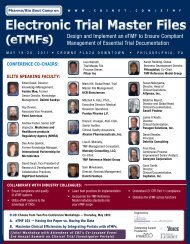Kendra Langhans - CBI
Kendra Langhans - CBI
Kendra Langhans - CBI
Create successful ePaper yourself
Turn your PDF publications into a flip-book with our unique Google optimized e-Paper software.
UTILIZE SIX SIGMA<br />
STRATEGIES FOR<br />
BUSINESS PROCESS<br />
IMPROVEMENT WITHIN<br />
MEDICAL AFFAIRS<br />
September 20, 2012
About <strong>Kendra</strong><br />
2<br />
BS Pharmacy, University of Kansas,<br />
MS Organic Chemistry, University of Michigan<br />
Various leadership roles in Medical Affairs<br />
including when Lilly established a US Medical<br />
Affairs group<br />
Six Sigma Black Belt – 3 years<br />
About 1.5 years into Lilly’s initiation of Six Sigma<br />
Currently Bio-Medicines Medical Affairs<br />
Strategy and Operations Advisor<br />
Copyright © 2012 Lilly
Definition of Six Sigma<br />
from Wikipedia<br />
3<br />
<br />
<br />
<br />
Six Sigma is a business management strategy, originally developed by Motorola<br />
in 1986. [1][2] ] Six Sigma became well known after Jack Welch made it a central focus<br />
of his business strategy at General Electric in 1995, [3] and today it is widely used in<br />
many sectors of industry.<br />
Six Sigma seeks to improve the quality of process outputs by identifying and<br />
removing the causes of defects (errors) and minimizing variability in<br />
manufacturing and business processes. [4] It uses a set of quality management<br />
methods, including statistical methods, and creates a special infrastructure of<br />
people p within the organization ("Black Belts", "Green Belts", etc.) who are experts in<br />
these methods. [4] Each Six Sigma project carried out within an organization follows a<br />
defined sequence of steps and has quantified financial targets (cost reduction and/or<br />
profit increase). [4]<br />
The term Six Sigma originated i from terminology associated with manufacturing,<br />
specifically terms associated with statistical modeling of manufacturing processes.<br />
The maturity of a manufacturing process can be described by a sigma rating<br />
indicating its yield or the percentage of defect-free products it creates. A six sigma<br />
process is one in which 99.99966% of the products manufactured are<br />
statistically expected to be free of defects (3.4 defects per million). Motorola set a<br />
goal of "six sigma" for all of its manufacturing operations, and this goal became a<br />
byword for the management and engineering Copyright © 2012 Lilly practices used to achieve it.
How Can Lean Six Sigma<br />
Help?<br />
<br />
<br />
<br />
Customer perceptions are driven by how well our products and<br />
services fulfill their requirements<br />
Lean Six Sigma focuses on defining those<br />
requirements and improving speed and quality to<br />
meet them<br />
Poor quality increases cost and customer lead time<br />
A 10% error rate can increase cycle time by 40%<br />
and reduce available working capacity<br />
In most value streams, > 95% of customer lead time is spent<br />
waiting<br />
Removing Lean Six non-value Sigma optimizes added capacity, time reduces and cycle effort time reduces<br />
cost performance, and improves and eliminates customer variability perceptions<br />
in all processes<br />
4<br />
Copyright © 2012 Lilly
How it all started<br />
5<br />
Employee Survey Data<br />
9<br />
8<br />
7<br />
6<br />
5<br />
4<br />
3<br />
2<br />
1<br />
0<br />
Q1 Q2 Q3<br />
Our employee survey data says we are not<br />
managing change well…..<br />
Can you use Six Sigma to fix this?<br />
Copyright © 2012 Lilly
6<br />
What We Found (during data<br />
collection)<br />
<br />
<br />
<br />
What changes were most painful:<br />
Process changes (new or updated d SOPs, Six Sigma, etc…)<br />
Re-organizations<br />
Root causes for poor change implementation:<br />
Poor communication: no rationale, seems secretive<br />
Inadequate stakeholder involvement (input)<br />
Failure to test/pilot before implementing<br />
Lack of follow-up<br />
Large number of changes that don't seem coordinated<br />
• Various Six Sigma and Business projects were ongoing from different sources<br />
• No one knew what projects were all ongoing!<br />
• There was duplication and overlap<br />
• There was re-work and confusion due to multiple projects working on the<br />
same process<br />
From a business perspective:<br />
e<br />
We didn’t know what resources we were using<br />
Priorities weren’t clear<br />
Copyright © 2012 Lilly
Solutions<br />
Phase 1 - Address communicating/influencing<br />
g<br />
change<br />
<br />
Implement new internal internet collaboration to include:<br />
Centralized coordination for all communications<br />
<br />
Collection of input for changes across the organization<br />
<br />
Share tools to ensure good Change Management<br />
Phase 2 – Address the coordination/prioritization<br />
of change<br />
Change Advisory Board to review and approve change<br />
projects (six sigma and non-six sigma) and implementation<br />
timingi<br />
Timeline and other Tools<br />
What projects are going on?<br />
<br />
<br />
<br />
When are current projects scheduled to roll-out<br />
out<br />
Assess capacity<br />
Combine solution roll-outs<br />
Copyright © 2012 Lilly
The “Change” Process…..<br />
8<br />
Identify<br />
Projects<br />
Prioritize<br />
Projects<br />
Implement<br />
Projects<br />
Sustain the<br />
Change<br />
Communication<br />
Copyright © 2012 Lilly
9<br />
Identify yprojects<br />
Lots of sources: employees, leaders, other<br />
projects<br />
You need to get all the ideas into one place<br />
Internal website with a simple form is one method<br />
Identify<br />
Projects<br />
Can see if an idea has already been submitted/being worked on<br />
Allow anyone to submit<br />
Best Practice - Six Sigma Consultant<br />
Best Practice -capture all projects, then sort<br />
out if Six Sigma<br />
Copyright © 2012 Lilly
Six Sigma Consultant<br />
10<br />
<br />
<br />
<br />
<br />
<br />
<br />
<br />
<br />
<br />
Black Belt assigned to various areas of the business<br />
Joins team and/or leadership meetings<br />
Listens for “pain” or problem areas<br />
Can proactively identify “good” projects<br />
Can help with charters<br />
Can help with prioritization iti and scope<br />
Will know the impact to the business because they are<br />
part of the business<br />
For the Belt it is an opportunity to learn more about the<br />
business and make potential career connections<br />
Belt may or may not do all the projects coming out of the<br />
assigned area of business<br />
Copyright © 2012 Lilly
11<br />
Efficiently Prioritize Projects Pi<br />
Once you have a list…….<br />
Best practices<br />
Six Sigma Consultant<br />
Prioritize iti<br />
Projects<br />
• Partners with business to understand the project<br />
• Writes charter (six sigma and non-six sigma)<br />
• Determines if truly a six sigma project or they just need<br />
someone to lead the project<br />
Advisory Board<br />
• Composed of leaders across the business<br />
• Owns the resources (team members)<br />
Copyright © 2012 Lilly
Advisory Board<br />
Meets every 2-3 weeks<br />
Composed of leaders from the various<br />
business functions<br />
Why this works:<br />
These leaders have accountability for the success of<br />
their functions and the business unit<br />
These leaders can make decisions<br />
These leaders can work together to make better<br />
prioritization decisions then any tools - JUDGEMENT<br />
Copyright © 2012 Lilly
Advisory Board<br />
<br />
<br />
<br />
Reviews ongoing projects<br />
Monitors status t updates and timing<br />
i<br />
Reviews new projects<br />
Decides prioritization<br />
Determines whether h to use Six Sigma resources<br />
Evaluates timing to start projects<br />
Consolidates similar projects<br />
Approves initiation iti of a project<br />
Reviews Projects for Implementation<br />
Approves implementation timing (not actual changes)<br />
Considers consolidating similar il projects solutions<br />
Reviews Feedback from Employee Surveys on<br />
“Change”<br />
<br />
Output: t a prioritized iti project list (what is most<br />
important) ordered by timing for implementation<br />
Copyright © 2012 Lilly
Potential Considerations for<br />
Prioritization<br />
Relative Benefit to Cost Ratio:<br />
<br />
<br />
<br />
<br />
<br />
<br />
<br />
<br />
Does it align with business priorities or objectives – is it important to<br />
the organization?<br />
Does it address a right to operate issue, e.g. a regulatory<br />
requirement?<br />
Does it increase productivity or save money?<br />
The cost or resources needed for the project<br />
Alignment with other initiatives<br />
iti Need to work in parallel or in series<br />
How broad is the impact or scope<br />
<br />
How many people does it impact<br />
Timing<br />
Something may be the most important project but resources may<br />
not be available<br />
Does it lead to transformational or incremental change?<br />
One may not be better then the other, not everything can be<br />
transformational!<br />
Copyright © 2012 Lilly
When to Use Six Sigma<br />
<br />
<br />
<br />
<br />
<br />
<br />
You have an important issue or goal<br />
Problem or goal must be clearly defined!<br />
You are willing to commit resources<br />
Your black belt is a precious commodity and will need a<br />
project team to work on the project<br />
The answer is not already known<br />
There is a process involved or a process needs to be<br />
created<br />
Six Sigma doesn’t plan resources or budgets but could be used<br />
to improve processes to free up resources or dollars<br />
You want a data driven solution<br />
Customer input is important<br />
Copyright © 2012 Lilly
16<br />
Implement and Sustain Change<br />
Across an Organization<br />
Impleme<br />
<br />
<br />
<br />
<br />
<br />
Communication is key<br />
nt<br />
Projects<br />
Early and often<br />
Collect input and keep broader group informed<br />
Best Practice: News site on collaboration space<br />
• Teams create brief updates at key milestones<br />
• RSS feed creates weekly news synopsis for organization<br />
Sustain<br />
the<br />
Change<br />
Best Practice: Challenge Teams: non-project team<br />
members who preview solutions and provide insight and<br />
challenges<br />
Best Practice: Pilot before broad implementation<br />
Best Practice: Advisory Board monitors progress and<br />
coordinates similar roll-outs<br />
Validate: 6 months post-implementation team gathers<br />
data and tweaks if necessary<br />
Copyright © 2012 Lilly
Using the Process for<br />
17<br />
Transformation<br />
Identify Prioritize Implement Sustain the<br />
Projects<br />
Projects<br />
Projects<br />
Change<br />
Copyright © 2012 Lilly
Example Capability<br />
Today<br />
Trusted<br />
Information<br />
• Tailored Dissemination<br />
Tomorrow<br />
Make available or disseminate relevant<br />
Let insights lead<br />
internal or external data and information in<br />
an accurate, timely, and preferred manner<br />
and channel to external customers<br />
Act in a more<br />
consultative<br />
information<br />
and<br />
collaborative<br />
From<br />
of customer way information into<br />
• Collection of customer<br />
• Synthesis and integration<br />
Information is<br />
disseminated in an<br />
accurate but “one<br />
insights and knowledge<br />
Tailor • Dissemination our of actions insights<br />
throughout the torganization<br />
b t “<br />
• Integrated size information fits all”<br />
generation and organization<br />
method.<br />
Lead the change<br />
To<br />
Make available or<br />
disseminate relevant<br />
data and information<br />
in an accurate,<br />
timely, and preferred<br />
manner and channel<br />
to all customers.<br />
Copyright © 2012 Lilly
Transformation Map<br />
2010<br />
2011 2012<br />
2013<br />
Strategic Intent:<br />
Truste ed Source<br />
Med Letter<br />
Transformation<br />
Benefit: Risk Communication<br />
Manuscpt Cycle<br />
Time Reduction<br />
Key Theme<br />
Key Theme<br />
Key Theme<br />
Copyright © 2012 Lilly
Example Medical Affairs Projects<br />
Medical Letter<br />
Revision<br />
• Use customer input to redesign medical letters<br />
• Content creation process<br />
• Fulfillment process<br />
Medical Website<br />
• Use DMEDI (Design) to create core content structure<br />
based on customer input<br />
• Functionality – Search, Email, Phone, w/enhanced content<br />
Call Center<br />
Escalation Process<br />
• Streamline escalation process from call center to Medical<br />
Affairs team<br />
Customer Focused<br />
Employees<br />
• Desire to have more customer focused employees<br />
• Identify what is “good” through VOC<br />
• Root cause analysis and solutions developed<br />
Data Integration<br />
• Data resides in multiple places, hard to integrate<br />
• Leverage SS to indentify what data the customer needs<br />
integrated (not all data needs to be integrated)<br />
• Identify root causes and develop solutions for key data<br />
integration<br />
Copyright © 2012 Lilly
Conclusion<br />
21<br />
<br />
<br />
<br />
Medical Affairs is the perfect place to leverage Six<br />
Sigma<br />
Medical Affairs organizations must be close to the customer,<br />
understand the customers needs, and meet those needs in a<br />
quick and efficient manner; exactly what Six Sigma is<br />
designed to do!<br />
Organizations can leverage Six Sigma Consultants t and<br />
Advisory Boards composed of functional leaders to<br />
maximize Six Sigma efforts<br />
Look outside the typical process box, can Six Sigma be<br />
used for a project you are currently facing?<br />
Copyright © 2012 Lilly



